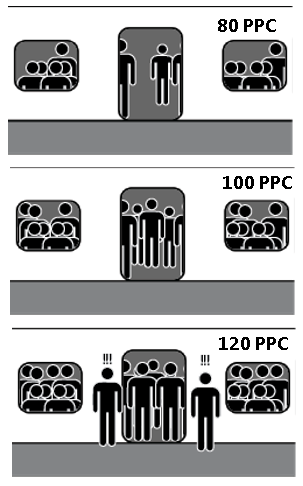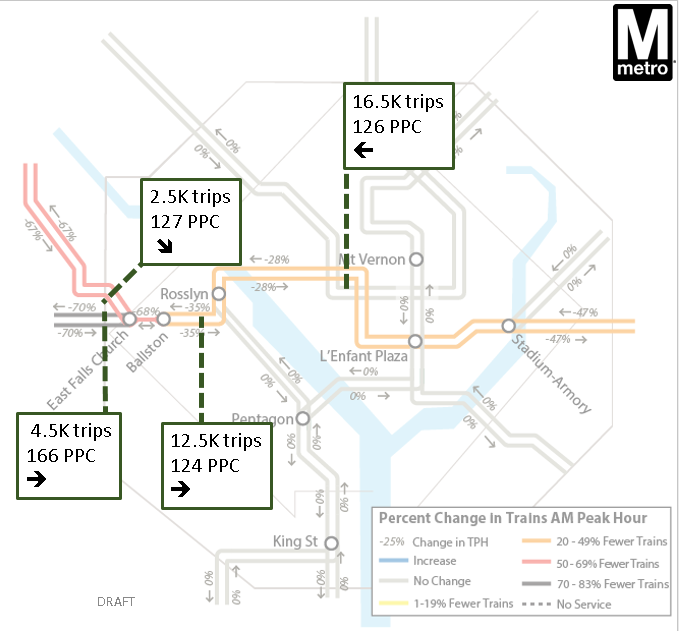Rail Car Crowding and SafeTrack – Potential Customer Impacts Analysis Released
We have developed a customer impact analysis that shows how and where customers may be impacted in the SafeTrack safety surges, to help guide regional partners plan mitigation and alternatives
 The first SafeTrack project began on June 4, meaning that Monday, June 6th, was the first day with peak-period service disruptions. This first safety surge is to accommodate the track improvement project planned for the Orange and Silver lines between East Falls Church and Ballston. With only one track available for revenue service, we are cutting back to just over 3 trains per hour on each line through the work zone. When service levels decrease without a decrease in demand, we see an increase in passenger loading on rail cars. We measure that with a metric called passengers per car, or PPC.
The first SafeTrack project began on June 4, meaning that Monday, June 6th, was the first day with peak-period service disruptions. This first safety surge is to accommodate the track improvement project planned for the Orange and Silver lines between East Falls Church and Ballston. With only one track available for revenue service, we are cutting back to just over 3 trains per hour on each line through the work zone. When service levels decrease without a decrease in demand, we see an increase in passenger loading on rail cars. We measure that with a metric called passengers per car, or PPC.
Our rail cars are designed to comfortably transport around 100 passengers each, with most sitting and a few customers standing. After special events (or any given weekday on some lines) we often find rail cars with much higher passenger loads. From a planning perspective, an average PPC of greater than 120 is considered crowded. Also, we know that customers don’t evenly distribute themselves across rail cars, so an average PPC of 120 means some cars are much more crowded.
Since the SafeTrack plan was first released, we have been working to assess the impacts to customers of the service decreases needed to accommodate the track work. We have developed a customer impacts analysis that shows for each project a schematic diagram of the service pattern, totals of peak-period customers impacted split out by severity of the impact, and AM peak hour PPCs at/through the work zones but also at other places along the rail network. This assessment assumes that no one modifies their behavior and all customer trips can be accommodated by the planned service. As you can see in the image below, the cuts in service due to the project starting this weekend could result in very high PPCs on the rail network on Orange/Blue/Silver in both directions during the peak hours through the core.
The customer impacts of the first five Surges were presented to an inter-jurisdictional planning and coordinating group that met at DDOT’s offices on June 1, 2016. That afternoon, the slide deck that had been presented was emailed to our jurisdictional partners. This new presentation (linked to above and below) includes a few key changes:
- Per the request of the group, an assessment of “excess demand” was added to each surge.
- A few small errors were fixed.
- The results of Surges 14 and 15 were updated to reflect corrected modeling results.
Because of the crowding levels we would see if no one changes their behavior, we are encouraging customers who have other options to avoid using the impacted lines during safety surges. This includes customers whose trips do not cross through the work zone.
We greatly appreciate your patience as we continue with this important set of safety improvements.
Download: Final SafeTrack impacts Peak 2016-06-01 PUBLIC (PDF)



For #6, the single tracking between Silver Spring & Takoma, couldn’t the Green Line Commuter Shortcut be revived?
Some trains could turn at Brookland to West Hyattsville, lessening the crush seen north of NoMa. It’s only a partial fix to the PPC problem, but could help out between Grosvenor & Brookland.